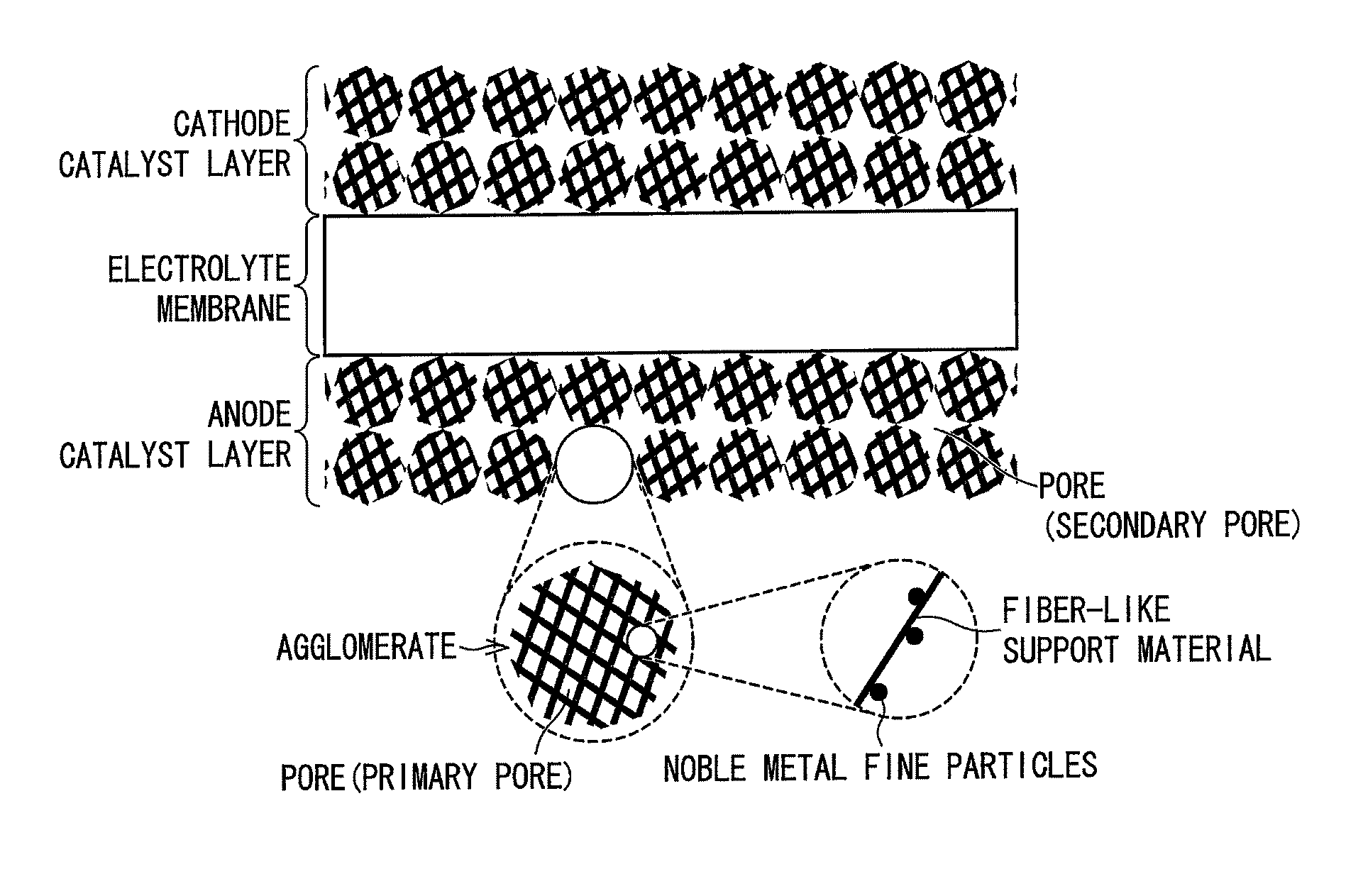Catalyst layer for fuel cell membrane electrode assembly, fuel cell membrane electrode assembly using the catalyst layer, fuel cell, and method for producing the catalyst layer
a fuel cell membrane electrode and catalyst layer technology, applied in the direction of cell components, physical/chemical process catalysts, sustainable manufacturing/processing, etc., can solve the problems of insufficient discharge of generated water from a cathode, insufficient release of generated gas from an anode, and the catalyst layer used for conventional fuel cell membrane electrodes suffers, etc., to achieve better electron conductivity, improve power generation performance, and improve structural stability
- Summary
- Abstract
- Description
- Claims
- Application Information
AI Technical Summary
Benefits of technology
Problems solved by technology
Method used
Image
Examples
example 1
2. Example 1
[0134]FIG. 3 is a drawing showing a fuel cell membrane electrode assembly in accordance with an example (Example 1) in which the catalyst layer of the present invention was used as an anode catalyst layer.
[0135]An anode catalyst layer in Example 1 was formed by spraying, to an electrolyte membrane, a catalyst dispersion liquid prepared by ultrasonicating a nanowire-supported PtRu-catalyst, a Nafion® solution, 2-propanol, and water.
[0136]The cathode catalyst layer in Example 1 was the same as that in Comparative Example 1 and an explanation thereof is omitted here.
3. Results of Analyses
[0137]SEM (scanning electron microscope) images of the catalyst layers of Example 1 and Comparative Example 1 were obtained and structures of respective catalyst layers were observed. The SEM images were obtained with a conventional field emission scanning electron microscope.
[0138]FIG. 4(a) is a drawing showing an SEM picture of the anode catalyst layer in Example 1 shown in FIG. 3. FIG. 4...
example 2
5. Example 2
[0162]FIG. 15 is a drawing showing a fuel cell membrane electrode assembly in accordance with an example (Example 2) in which the catalyst layer of the present invention was used as a cathode catalyst layer.
[0163]In Example 2, a cathode catalyst layer was prepared in the same manner as preparation of the anode catalyst layer in Example 1 except that the materials for catalysts are different. Specifically, the material for the catalyst in Example 1 is a nanowire-supported PtRu catalyst, whereas the material for the catalyst in Example 2 is a nanowire-supported Pt catalyst. Except for this difference, a Nafion solution, a solvent etc. are common between the anode catalyst layer in Example 1 and the cathode catalyst layer in Example 2.
[0164]Further, in Example 2, an anode catalyst layer was prepared in the same manner as preparation of the anode catalyst layer in Comparative Example 2. Cathode polarization performance was evaluated by feeding hydrogen to the anode and air t...
example 3
Preparation of Electrochemical Catalyst Nanoparticles and Nanowire-Supported Electrochemical Catalyst Nanoparticles
Materials:
[0296]RuCl3.xH20 (Aldrich), H2PtCl6.xH20 (Aldrich), Anhydrous ethylene glycol (Aldrich) and 0.5 M NaOH ethylene glycol solution.
Preparation:
[0297]250 mg RuCl3.xH20 was added to a 150 mL three-neck flask. 30 mL of ethylene glycol was added and stirred with a magnetic stirring bar until a clear solution was formed (approximately a few hours). 500 mg of H2PtCl6.xH20 and an additional 200 mL of ethylene glycol were then added. 50 mL of 0.5 M NaOH solution was added, and the solution was purged with Ar gas. The solution was then heated in an oil bath at about 165° C. for about 3 hours to produce a Pt:Ru colloid solution.
[0298]100 mg of carburized nanowires suspended in 10 mL of ethylene glycol were dispersed via sonication. The dispersion was transferred to a 250 mL beaker.
[0299]15 mL of the Pt:Ru colloid solution was then added to the nanowires, and nitric acid of...
PUM
| Property | Measurement | Unit |
|---|---|---|
| pore size | aaaaa | aaaaa |
| pore size | aaaaa | aaaaa |
| pore size | aaaaa | aaaaa |
Abstract
Description
Claims
Application Information
 Login to View More
Login to View More - R&D
- Intellectual Property
- Life Sciences
- Materials
- Tech Scout
- Unparalleled Data Quality
- Higher Quality Content
- 60% Fewer Hallucinations
Browse by: Latest US Patents, China's latest patents, Technical Efficacy Thesaurus, Application Domain, Technology Topic, Popular Technical Reports.
© 2025 PatSnap. All rights reserved.Legal|Privacy policy|Modern Slavery Act Transparency Statement|Sitemap|About US| Contact US: help@patsnap.com



